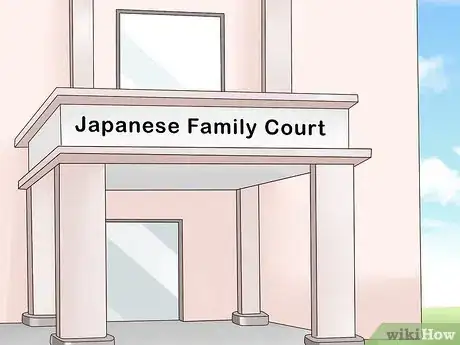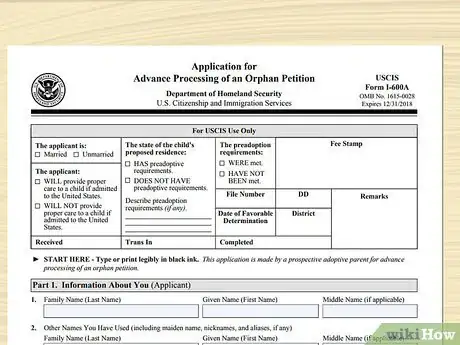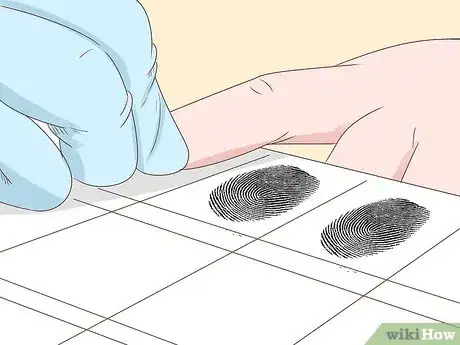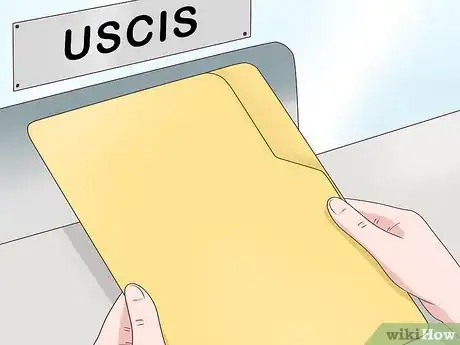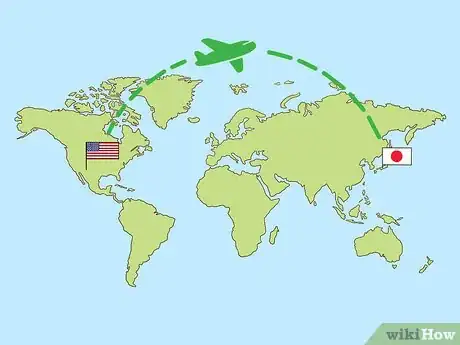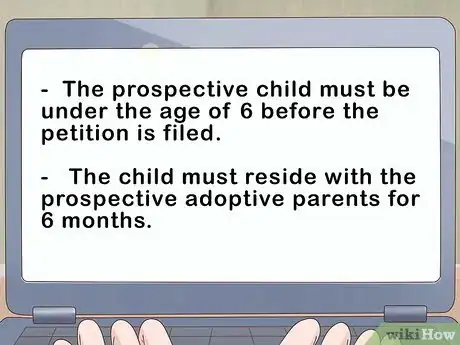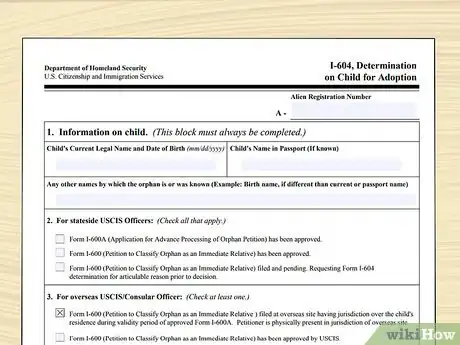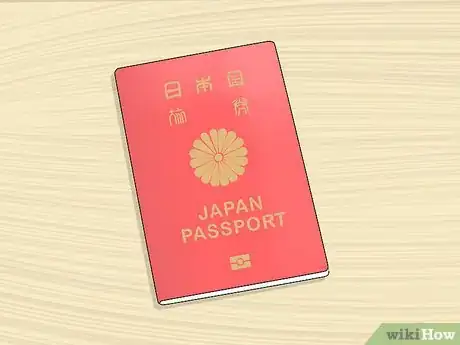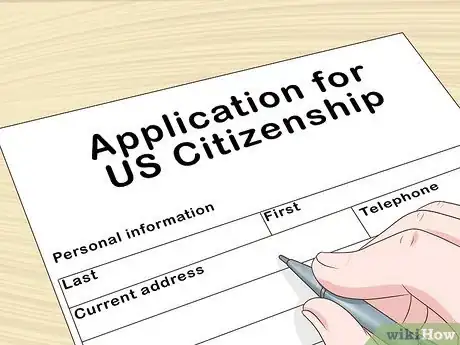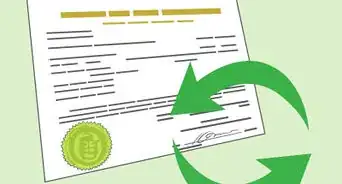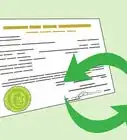This article was co-authored by Clinton M. Sandvick, JD, PhD. Clinton M. Sandvick worked as a civil litigator in California for over 7 years. He received his JD from the University of Wisconsin-Madison in 1998 and his PhD in American History from the University of Oregon in 2013.
There are 7 references cited in this article, which can be found at the bottom of the page.
This article has been viewed 55,085 times.
Adopting a child is an exciting but complex process, and the particular steps prospective parents must take will vary greatly depending on the parents' and child's countries. If you are an American adopting a baby from Japan, you are not governed by the Hague Convention, and as a result will have a distinct set of paperwork during the adoption process. Adoptions in Japan are mostly done via private agencies, but you may need to be in communication with several Japanese government agencies at various points throughout the process. Aside from Japanese procedures, there are also a number of U.S. requirements that you and your prospective adopted baby must meet in order to complete the process of international adoption. Learning what paperwork to complete can help you make sense of the adoption process and bring home your new child.
Steps
Starting Procedures in the United States
-
1Ensure that you qualify. Before you can actually begin the adoption process, you should take steps to ensure that you qualify for an international adoption. Because the adoption is an international coordination, there are certain conditions that must be met in order for the process to be approved.
- The adopting parents must typically live in Japan throughout the entire court process. This requires a minimum stay of six months, but the court process may take up to 18 months. At least one parent must be in attendance at the court when the case is finalized.[1]
- Typically, the adopting parents must be a married couple. Exceptions are sometimes made for single parents on a case-by-case basis.[2]
- The adopting parents will have to provide some proof of income and financial savings to prove that they can provide for the child.[3]
- In a specialized adoption, which allows the parents to secure a US visa for the child, both of the adopting parents must be at least 20 years of age, with at least one parent over 25 years of age.[4]
-
2Select an adoption service provider. The first step in beginning the adoption process is to choose an accredited/approved adoption service provider from the country you will be adopting from (in this case Japan). The adoption service provider is a specialized adoption agency or individual, typically with a background in family counseling or social work.
- The adoption service provider serves as the primary provider for your adoption case.[5]
- The most common primary providers in Japan include the Japanese Family Court, the Child Guidance Center, and private parties like missionaries, social welfare groups, or adoption services.
- When comparing primary providers, look at each provider's number of annual adoption placements over the past three years and the percentage of those placements that remained intact. This information is available upon request from each provider and will give you a good idea of how successful each provider has been in recent years.[6]
- You should also ask each provider how many adoption-eligible children they represent.[7]
Advertisement -
3Fill out Form I-600A. Once you've selected an adoption service you'll need to fill out Form I-600A, the Application for Advance Processing of Orphan Petition with the United States Citizenship and Immigration Services. This form is used by the US Citizenship and Immigration Services (USCIS) to evaluate your qualifications as a parent and make a formal judgment on whether or not you qualify for an international adoption.[8]
- Form I-600A must be completed before the actual adoption process begins. Even if you have already identified a child to adopt from Japan, the child must remain in Japan while Form I-600A is filed in the United States.[9]
- If your application is approved by the USCIS, you will receive a written notification through the mail. Your approval is valid for 18 months. If the adoption has not been completed in that time period, you will have to begin the application process from the beginning.[10]
- Because Japan is a non-Hague Convention country, you do not need to fill out Form I-800A, the Application for Determination of Suitability to Adopt a Child from a Convention Country.[11]
-
4Submit your fingerprints. The USCIS conducts FBI background checks on all prospective adoptive parents. These checks are performed using fingerprinting records. Successful fingerprint and background checks are only valid for 15 months, so it's important to begin the adoption process as soon as possible.
- The USCIS charges $80 per person at the time of filing for fingerprint and background checks. This must be completed at an authorized location, including USCIS offices, US Application Support Centers, and US embassies and military offices abroad.[12]
-
5Have a home study performed. A home study consists of an in-person interview and other procedures designed to review the fitness of you and your home environment. The individual who conducts the study will evaluate your physical, mental, and financial capabilities, as well as your current living conditions.[13]
-
6File your completed form with the USCIS. You will also need to send in a filing fee of $720, plus an additional $85 fee for every individual living in your household over the age of 18.[14]
Applying to Adoption Agencies in Japan
-
1Travel to Japan. Japanese adoption law requires that at least one prospective parent be physically present in Japan to initiate proceedings. Adoption by proxy is not allowed.[15]
-
2Consider hiring a Japanese attorney. An attorney is not mandatory, but may be useful in navigating Japanese adoption law. The Family Court in Japan finalizes all adoption cases, and certain paperwork must be filed with the clerk's office. Having an attorney who is fluent in Japanese and well-versed in Japanese law would be an invaluable aid during this process.[16]
-
3Learn Japan's guidelines. In addition to meeting the guidelines for adopting a child in the United States, prospective parents wishing to complete a special adoption must also meet Japan's guidelines for adoption. The child must also meet certain guidelines to be adopted internationally.[17]
- The prospective child must be under the age of 6 before the petition is filed or below the age of 8 if the child has been under the care of the prospective parents since before the child reached age 6.[18]
- The child must reside with the prospective adoptive parents for 6 months before the Family Court will issue an adoption decree.[19]
-
4Prepare the necessary documents. Prospective parents must have numerous documents signed, notified, or otherwise authenticated. These documents include:
- birth certificates[20]
- passports[21]
- Japanese visas[22]
- marriage certificates[23]
- certificate of no criminal record (obtained from each parent's home city or state police department in the United States)[24]
- certificate of legal address, employment, and bank statements[25]
- copy of property ownership deeds (if applicable)[26]
- biographic histories of both parents[27]
- statement of consent to adopt by the child's current guardian[28]
- statement of prospective parents' intent to adopt[29]
- home study approved by a licensed adoption agency[30]
- two character references[31]
Finalizing the Adoption
-
1Verify that the child can be legally classified as an orphan according to U.S. immigration law. Some adoptable children in Japan do not qualify as orphans by the definition used in the US, and only children who qualify as orphans by that definition can receive an immigrant visa. In order to qualify as an orphan a child must have lost both parents, generally through death or abandonment. The child of a single parent is rarely labeled as an orphan, but an exception might be made if the parent cannot care for the child and surrenders custody.[32]
-
2File Form I-604 with the USCIS. Form I-604, the Report on Overseas Orphan Investigation, is used to verify the child's orphan status. Even though the I-600 can be completed before you have a child in mind for adoption, the I-604 must be completed only after you have a specific child in mind. This investigation will be performed by a consular office during the child's interview for an immigrant visa, and may take upwards of several months to complete.[33]
-
3Apply for the child's paperwork. Since your child is not yet a U.S. citizen, he or she will need a Japanese passport to come back with you to the United States. Contact Japan's Ministry of Foreign Affairs and the US Embassy in Tokyo to obtain the necessary paperwork.
- You will need to apply for and secure a new birth certificate for the child that includes your name. You will also need to apply for a family registry for the child. Both of these documents will be needed to secure a passport. Your adoption service provider can assist you during this process.[34]
- Once you have the child's birth certificate and family registry, you'll need to secure a travel document or passport from Japan.[35]
- You will also need to apply for a US immigrant visa for the child. This can be acquired through the US Embassy in Tokyo. Prior to the immigrant visa interview, you should submit an Electronic Immigrant Visa Application (Form DS-260), which can be found online at the Consular Electronic Application Center.[36]
- Bring a printed-out copy of the DS-260 form completion page to the visa interview.[37]
-
4Acquire US citizenship for the child. If the adoption has been approved and finalized before returning to the United States, the child will automatically earn US citizenship, provided that the child meets the requirements of the Child Citizenship Act of 2000.[38] The child's requirements for citizenship include:
- being under 18 years of age[39]
- gaining legal admission as an immigrant for lawful permanent residence[40]
- having at least one adoptive parent who is an American citizen, either by birth or naturalization[41]
- living in the legal and physical custody of the parent who is a lawful American citizen[42]
Warnings
- The average total cost of an international Japanese adoption is somewhere around $20,000, including fees for the Family Court and the adoption agency, immigration processing, and document translations. This does not include airfare or lodging. Additionally, Japanese adoption service providers charge fees that can range from $5,000 to $50,000 USD or higher. There may be additional fees if the adoptive child has any existing medical conditions. Before you begin the adoption process, ensure that you have enough money to cover these costs.[43]⧼thumbs_response⧽
References
- ↑ http://travel.state.gov/content/adoptionsabroad/en/country-information/learn-about-a-country/japan.html
- ↑ http://travel.state.gov/content/adoptionsabroad/en/country-information/learn-about-a-country/japan.html
- ↑ http://travel.state.gov/content/adoptionsabroad/en/country-information/learn-about-a-country/japan.html
- ↑ http://travel.state.gov/content/adoptionsabroad/en/country-information/learn-about-a-country/japan.html
- ↑ http://travel.state.gov/content/adoptionsabroad/en/country-information/learn-about-a-country/japan.html
- ↑ http://travel.state.gov/content/adoptionsabroad/en/adoption-process/how-to-adopt/working-with-an-adoption-service-provider.html
- ↑ http://travel.state.gov/content/adoptionsabroad/en/adoption-process/how-to-adopt/working-with-an-adoption-service-provider.html
- ↑ http://www.uscis.gov/i-600a
- ↑ http://travel.state.gov/content/adoptionsabroad/en/adoption-process/who-can-adopt/eligibility-to-adopt.html
- ↑ http://travel.state.gov/content/adoptionsabroad/en/adoption-process/who-can-adopt/eligibility-to-adopt.html
- ↑ http://travel.state.gov/content/adoptionsabroad/en/country-information/learn-about-a-country/japan.html
- ↑ http://travel.state.gov/content/adoptionsabroad/en/adoption-process/who-can-adopt/eligibility-to-adopt.html
- ↑ http://travel.state.gov/content/adoptionsabroad/en/country-information/learn-about-a-country/japan.html
- ↑ http://travel.state.gov/content/adoptionsabroad/en/adoption-process/who-can-adopt/eligibility-to-adopt.html
- ↑ http://travel.state.gov/content/adoptionsabroad/en/country-information/learn-about-a-country/japan.html
- ↑ http://travel.state.gov/content/adoptionsabroad/en/country-information/learn-about-a-country/japan.html
- ↑ http://travel.state.gov/content/adoptionsabroad/en/country-information/learn-about-a-country/japan.html
- ↑ http://travel.state.gov/content/adoptionsabroad/en/country-information/learn-about-a-country/japan.html
- ↑ http://travel.state.gov/content/adoptionsabroad/en/country-information/learn-about-a-country/japan.html
- ↑ http://travel.state.gov/content/adoptionsabroad/en/country-information/learn-about-a-country/japan.html
- ↑ http://travel.state.gov/content/adoptionsabroad/en/country-information/learn-about-a-country/japan.html
- ↑ http://travel.state.gov/content/adoptionsabroad/en/country-information/learn-about-a-country/japan.html
- ↑ http://travel.state.gov/content/adoptionsabroad/en/country-information/learn-about-a-country/japan.html
- ↑ http://travel.state.gov/content/adoptionsabroad/en/country-information/learn-about-a-country/japan.html
- ↑ http://travel.state.gov/content/adoptionsabroad/en/country-information/learn-about-a-country/japan.html
- ↑ http://travel.state.gov/content/adoptionsabroad/en/country-information/learn-about-a-country/japan.html
- ↑ http://travel.state.gov/content/adoptionsabroad/en/country-information/learn-about-a-country/japan.html
- ↑ http://travel.state.gov/content/adoptionsabroad/en/country-information/learn-about-a-country/japan.html
- ↑ http://travel.state.gov/content/adoptionsabroad/en/country-information/learn-about-a-country/japan.html
- ↑ http://travel.state.gov/content/adoptionsabroad/en/country-information/learn-about-a-country/japan.html
- ↑ http://travel.state.gov/content/adoptionsabroad/en/country-information/learn-about-a-country/japan.html
- ↑ http://www.uscis.gov/tools/glossary/orphan
- ↑ http://travel.state.gov/content/adoptionsabroad/en/country-information/learn-about-a-country/japan.html
- ↑ http://travel.state.gov/content/adoptionsabroad/en/country-information/learn-about-a-country/japan.html
- ↑ http://travel.state.gov/content/adoptionsabroad/en/country-information/learn-about-a-country/japan.html
- ↑ https://ceac.state.gov/IV/Login.aspx
- ↑ http://travel.state.gov/content/adoptionsabroad/en/country-information/learn-about-a-country/japan.html
- ↑ http://travel.state.gov/content/adoptionsabroad/en/country-information/learn-about-a-country/japan.html
- ↑ http://travel.state.gov/content/adoptionsabroad/en/adoption-process/faqs/child-citizenship-act-of-2000.html
- ↑ http://travel.state.gov/content/adoptionsabroad/en/adoption-process/faqs/child-citizenship-act-of-2000.html
- ↑ http://travel.state.gov/content/adoptionsabroad/en/adoption-process/faqs/child-citizenship-act-of-2000.html
- ↑ http://travel.state.gov/content/adoptionsabroad/en/adoption-process/faqs/child-citizenship-act-of-2000.html
- ↑ http://travel.state.gov/content/adoptionsabroad/en/country-information/learn-about-a-country/japan.html

